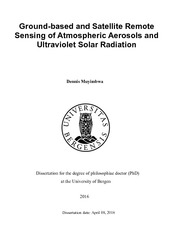| dc.contributor.author | Muyimbwa, Dennis | |
| dc.date.accessioned | 2016-04-13T07:35:11Z | |
| dc.date.available | 2016-04-13T07:35:11Z | |
| dc.date.issued | 2016-04-08 | |
| dc.identifier.uri | https://hdl.handle.net/1956/11903 | |
| dc.description.abstract | Satellite remote sensed data have been used to determine the aerosol climatology and to investigate the influence of the aerosol index (AI) on the ultraviolet (UV) index in coastal land areas in Serrekunda (13.28◦ N, 16.34◦ W, 17 m), The Gambia, and Dar-es- Salaam (6.8◦ S, 39.26◦ E, 24 m), Tanzania, as well as in inland areas in Kampala (0.31◦ N, 32.58◦ E, 1200 m), Uganda. Over three decades of satellite data (1979–1994 and 1996–2012) from total ozone mapping spectrometer (TOMS) and ozone monitoring instrument (OMI), which have provided measurements of backscattered radiances in the wavelength range from 331 to 380 nm, have been used. We found a high correlation coefficient between UV index and AI of 0.82 for Serrekunda, but poor correlation for Kampala and Dar-es-Salaam. The average AI for Serrekunda was found to be about three times higher than that for Kampala or Dar-es-Salaam, and a positive trend with time of the AI was found for Kampala and Dar-es-Salaam, whereas a negative trend was found for Serrekunda. The OMI overpass UV indices were validated against the ground-based UV indices derived from NILU-UV irradiance measurements in Kampala, Uganda for the period between 2005 and 2014. It was found that the UV index values follow a seasonal pattern with maximum values in March and October. Under all-sky conditions, the OMI retrieval algorithm was found to overestimate the UV index values with a mean bias of about 28%. But under cloud/aerosol-free sky conditions, the mean bias reduced to values less than 10%. The overestimation of the UV index by the OMI retrieval algorithm was found to be mainly due to clouds and aerosols. An excessive use of old cars, which would imply a high loading of absorbing aerosols, could have been the reason for the increase with time in the AI for Kampala. Direct solar radiances measured at a ground-based station in Bergen, Norway be- tween February 2012 and April 2014, have been analyzed. It was found that the spectral aerosol optical thickness (AOT) and precipitable water vapor column (PWVC) retrieved from these measurements have a seasonal variation with highest values in summer and lowest values in winter. The highest value of the monthly median AOT at 440 nm of about 0.16 was measured in July and the lowest of about 0.04 was measured in Decem- ber. The highest value of the monthly median PWVC of about 2.0 cm was measured in July and the lowest of about 0.4 cm was measured in December. The Ångström expo- nent was derived and used to deduce aerosol particle size distributions. We found that coarse-mode aerosol particles dominated most of the time during the measurement pe- riod, but fine-mode aerosol particles dominated during the winter seasons. The derived Ångström exponent values suggested that aerosols containing sea salt could have been dominating at this station during the measurement period. In a comparison study conducted on aerosol data from AERONET (Aerosol Robotic Network) sites in Northern Norway and Svalbard, at Andenes (69.28◦ N, 16.01◦ E, 379 m) and Hornsund (77.00◦ N, 15.56◦ E, 10 m) for the period between 2008 and 2013, it was found that the five/six-year annual mean values of the AOT at 500 nm at Andenes and Hornsund were both 0.09. Less variation of the monthly mean value of the AOT at 500 nm was found at Hornsund than at Andenes. The annual mean values of the Ångström exponent of about 1.29 and 1.34 were respectively measured at Andenes and Hornsund. An Ångström exponent value of larger than 1.1 was respectively found in 68% and 84% of the observations at Andenes and Hornsund, which implies that fine- mode particles were dominating at both sites during the observation period. Despite the differences in their geographical locations with Hornsund in the arctic and Andenes in sub-arctic, both sites had a similar aerosol size distribution during summer. | en_US |
| dc.language.iso | eng | eng |
| dc.publisher | The University of Bergen | en_US |
| dc.relation.haspart | Paper 1: T. Ssenyonga, D. Muyimbwa, W. Okullo, Y. -C. Chen, Ø. Frette, B. Hamre, A. Steigen, A. Dahlback, and J. J. Stamnes, Aerosols in coastal and inland areas in the equatorial African belt, Appl. Opt. 53, 2964–2973, 2014. This article is not available in BORA. The published version is available at: <a href="http://dx.doi.org/10.1364/AO.53.002964" target="blank"> 10.1364/AO.53.002964</a> | en_US |
| dc.relation.haspart | Paper 2: D. Muyimbwa, A. Dahlback, T. Ssenyonga, Y. -C. Chen, J. J. Stamnes, Ø. Frette, and B. Hamre, Validation of ozone monitoring instrument ultraviolet index against ground-based UV index in Kampala, Uganda, Appl. Opt. 54, 8537–8545, 2015. This article is not available in BORA. The published version is available at: <a href="http://dx.doi.org/10.1364/AO.54.008537" target="blank">10.1364/AO.54.008537</a> | en_US |
| dc.relation.haspart | Paper 3: D. Muyimbwa, Ø. Frette, J. J. Stamnes, T. Ssenyonga, Y. -C. Chen, and B. Hamre, Aerosol optical properties and precipitable water vapor column in the atmosphere of Norway, Appl. Opt. 54, 1505–1514, 2015. This article is not available in BORA. The published version is available at: <a href="http://dx.doi.org/ 10.1364/AO.54.001505" target="blank"> 10.1364/AO.54.001505</a> | en_US |
| dc.relation.haspart | Paper 4: Y. -C. Chen, B. Hamre, Ø. Frette, D. Muyimbwa, S. Blindheim, K. Stebel, P. Sobolewski, C. Toledano, and J. J. Stamnes, Aerosol optical properties in Northern Norway and Svalbard, Appl. Opt. in press, 2016. This article is not available in BORA. The published version is available at: <a href="http://dx.doi.org/ 10.1364/AO.55.000660" target="blank">10.1364/AO.55.000660</a> | en_US |
| dc.title | Ground-based and Satellite Remote Sensing of Atmospheric Aerosols and Ultraviolet Solar Radiation | en_US |
| dc.type | Doctoral thesis | |
| dc.rights.holder | Copyright the author. All rights reserved. | en_US |
